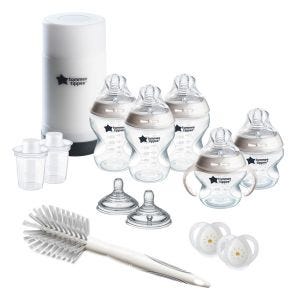
This is a demo store. No orders will be fulfilled.
Subscription orders can be cancelled at anytime. Free delivery on all subsequent subscription orders. Find out more about subscriptions.
They’re easy and fuss free
Your products are automatically sent to you
You save up to 10% when you sign up for a subscription
You can cancel at any time
Learning to smile is an important milestone on the timeline of a baby's visual and social development. And their little tot's first smile is an emotional memory that's treasured by a parent forever.
Some may argue that there's nothing cuter than a tiny toothless grin! So, let's run through when most babies first show signs of what's known as 'reflex' smiling, and when you can expect to see their first proper 'social' smile.
Babies who smile from birth and developing babies who appear to smile in the womb during second-trimester ultrasound scans are displaying something known as neonatal reflex smiling.
These smiles often happen between birth and one month of age when a baby is passing wind, falling asleep or feeling comfortable. Although they're adorable, they're not caused by what a baby has seen or heard.
You can think of reflex smiles as trail runs as your baby learns how their mouth moves and practises using their facial muscles. Even though they're spontaneous and shorter than the real deal, that doesn't mean they're not super cute!
Social smiles are smiles that are triggered in response to something that a baby sees or hears that makes them feel happy or loved - like your voice or eye contact. They usually happen when a baby is alert and wide awake.
Social smiles require a baby to use their whole face, not just their mouth - think raised eyebrows and wide-open eyes!
You'll likely see your little one's first real social smile from around two or three months of age.
These first social smiles are a key development milestone on the road to learning to talk. They show that your baby is starting to learn how to communicate feelings of playfulness and joy.
Other adorable signs that your baby is happy and content include...
From three and four months old, babies begin to smile when they recognise familiar voices and faces, and they start to be able to chat and gurgle along with you as you coo at them.
As with all aspects of a baby's development, there's no exact timeline that a baby should follow when learning to smile. All little ones are different, but here's a rough guide to when they usually start to smile.
At first, a newborn baby's eyesight isn't fully developed. The world around them may look a little fuzzy, and they're not able to focus beyond six to 10 inches. At this stage, they will struggle to maintain eye contact and focus on your face.
As they grow, your baby's eyesight will begin to improve, and they'll be able to focus on and follow your face. They'll start to notice your facial expressions, and be able to recognise when you smile, stick your tongue out, or raise your eyebrows.
By around eight weeks old, most little ones will debut their first smile. This is a real moment to cherish, so get your camera ready! By three months old, they'll start to become a lot more socially engaged with you. When you smile and chat to them, they'll be able to mirror your response by grinning and gurgling.
At around three to four months old, most babies can hold your gaze and recognise the faces of their favourite people. It's around this time that you might notice that your baby needs to take time to get used to new faces.
By the time they hit the six-month milestone, most little ones can babble, giggle, and give big cheesy grins. Games of peek-a-boo will delight them, and their little personality will start to shine as they become more curious and adventurous every day.
You can try out the following tips to help your baby learn how to smile and coax out their first gummy grins, but remember not to force it. Ultimately, your baby will flash their first heart-breaking smile when they're ready!
If your little one was born prematurely, they may take a little longer to learn how to smile than a full-term baby would. But as a rule, you should seek advice from your family doctor or health visitor if your baby isn't showing signs of social smiling by the time they're around three or four months old.
If they're vocal, able to make and maintain eye contact, and respond to verbal and visual cues from you, it's probably nothing to worry about. They may just not be a smiley person at this early stage in their life. That said, not smiling can sometimes be a sign of a developmental delay or issue, and if that's the case, your doctor can support you and your baby.